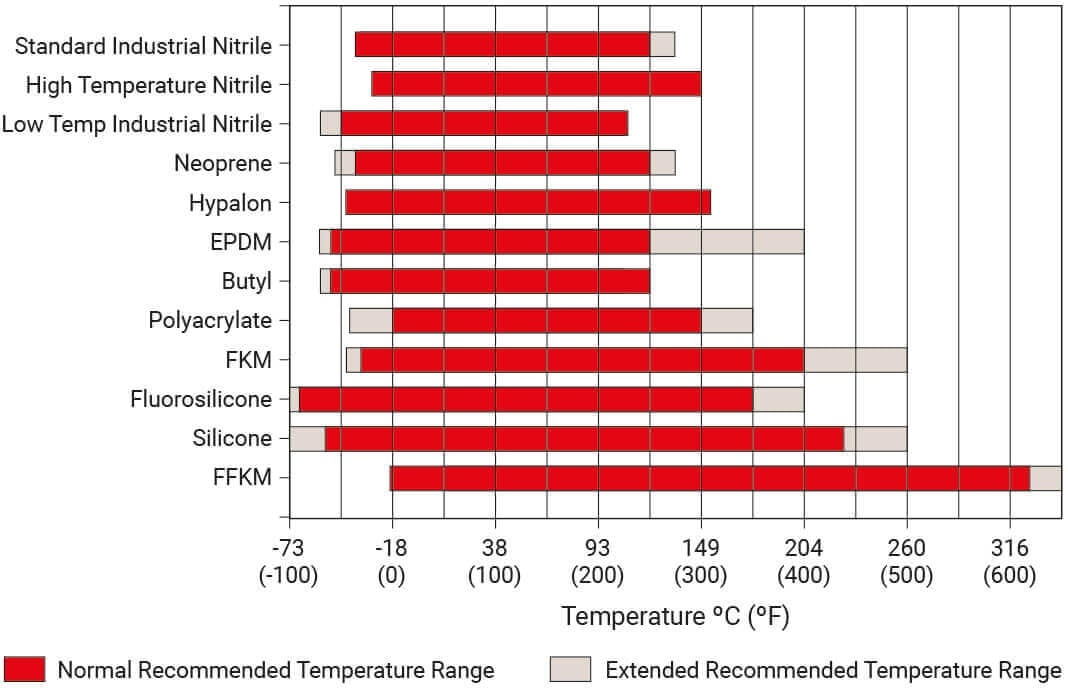
Fire Resistant Rubbers
Many rubber materials can be specially compounded to be fire-resistant. Silicone, EPDM, Vamac® Ethylene Acrylic Elastomer, Neoprene, Natural Rubber & Nitrile can all be compounded with special F.R. (fire retardant) additives to make them fire-resistant.
The addition of flame blocking ingredients like Antimony Trioxide & Decabromodiphenyl are widely used to provide effective fire resistance.
Materials that are inherently halogen-free are better to start with, such as Silicone & Vamac® Ethylene Acrylic Elastomer for example.
Materials such as Neoprene (Polychloroprene) are based on certain chemical ingredients including Chlorine. Chlorine, bromine, fluorine & iodine are halogen’s, which means that when on fire these ingredients can release substances that are toxic to humans in the form of toxic fumes.
Materials containing halogens need to be heavily loaded with blockers to make them fire-resistant & this can result in a sacrifice of mechanical properties, such as lower tensile strength, elongations and noticeably higher specific gravity.
Is Silicone Rubber fire resistant?
Whilst most Silicones have inherently good flame resistance as standard, they can still be compounded with blockers to meet high levels & standards of flame retardancy. Silicones are low smoke materials. Just set fire to a piece of standard Silicone & when it does catch fire it will give off smoke levels almost the same as cigarette smoke.
Is EPDM fire resistant?
Containing no halogen gives EPDM materials a good level of flame resistance but like with Silicones, they need to be compounded with blockers to meet rigid fire standard specifications.
Is Neoprene Rubber fire resistant?
CR / Neoprene is in no regards a fire retardant material, but it is much less flammable than other commercial rubber materials. When aflame the material will begin to melt but can be easily extinguished.
Is Viton™/FKM Fire Resistant?
Viton™ /FKM is ideal for high-end sealing applications, having the best fluid resistance of all commercial materials. It is also capable of withstanding high temperatures.
Whilst Viton™ /FKM has the lowest probability of catching fire, under excessively high temperatures ( or fire) FKM’s decompose often releasing toxic hydrogen fluoride which is dangerous.
Temperature Capabilities of Elastomers (Dry Air)
Material Reference
The chart below is intended to help in the material selection stage of designing rubber parts/products. Rubber compounding is a very broad and technical field, since basic rubbers or elastomers are mixed with various chemicals and ingredients (and even with each other) to obtain desired physical properties.
A wide variety of basic polymers (rubbers) are available, and a literally infinite array of compounds exhibiting unique physical properties as well as chemical, fluid and temperature resistances are possible. This chart, therefore, deals only with very general features of the most common basic rubber or elastomer compounds but more specific information is available upon request.

High performance, low smoke, low toxicity, elastomer materials and components for Rail/Mass Transit safety
Following the rollout, implementation, and updating of European Standard EN 45545-2 : 2020, J-Flex developed a wide range of elastomeric products & materials that meet the latest requirements of this norm, for Rolling Stock, Trackside Equipment & Construction Products/Building Elements.
Safety is not something a lot of commuters tend to think about. However, before any new transportation vehicle has been certified for use on our roads or rails it needs to pass a series of tests. These tests are designed to account for even the most unlikely of circumstances, to ensure that users are safe at all times.
The introduction of the new fire resistant rubber sheeting is just one of many new criteria that have been set up to not only minimise risks, but also to provide a cleaner experience for everyone. This new rubber sheeting is a massive step when it comes to providing superior safety, particularly in the rail industry.
As with all our industrial rubber solutions, we have ensured that our products have been fully tested. Not only are they approved to EN 45545-2, which is required for rail refurbishers, we also have further certifications.